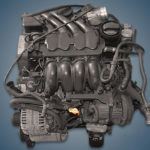The 1.6-liter 8-valve Audi AEH engine was produced by the concern from 1996 to 2007 and was installed on such popular models as the A3 8L, Golf 4 and Toledo 2. This motor is designed for Euro 2 environmental standards: it has no EGR, one lambda probe and mass air flow sensor instead of absolute pressure sensor.
The EA113-1.6 series includes: AEH, AHL, AKL, ALZ, ANA, APF, ARM, AVU, BFQ, BGU, BSE, BSF.
Specifications
| Production years | 1996-2007 |
| Displacement, cc | 1595 |
| Fuel system | injector |
| Power output, hp | 100 |
| Torque output, Nm | 145 |
| Cylinder block | aluminum R4 |
| Block head | aluminum 8v |
| Cylinder bore, mm | 81 |
| Piston stroke, mm | 77.4 |
| Compression ratio | 10.2 |
| Features | SOHC |
| Hydraulic lifters | yes |
| Timing drive | belt |
| Phase regulator | no |
| Turbocharging | no |
| Recommended engine oil | 5W-40 (approval: VW 502 00 or VW 505 00) |
| Engine oil capacity, liter | 4.5 |
| Fuel type | petrol |
| Euro standards | EURO 2 |
| Fuel consumption, L/100 km (for Audi A3 1997) — city — highway — combined |
10.5 5.9 7.6 |
| Engine lifespan, km | ~350 000 |
The engine was installed on:
- Audi A3 1 (8L) in 1996 – 2001;
- Seat Cordoba 1 (6K) in 1999 – 2002;
- Seat Ibiza 2 (6K) in 1999 – 2002;
- Seat Leon 1 (1M) in 1999 – 2005;
- Seat Toledo 2 (1M) in 1998 – 2004;
- Skoda Octavia 1 (1U) in 1997 – 2007;
- Volkswagen Bora 1 (1J) in 1998 – 2005;
- Volkswagen Golf 4 (1J) in 1998 – 2004;
- Volkswagen Polo 3 Classic (6V) in 1999 – 2001.
Disadvantages of the Audi AEH engine
- This is a simple and reliable motor, with proper maintenance it has a huge resource.
- Many of his problems are related to air leaks, see pipes and manifold.
- Also, a number of components of the ignition system are not the highest resource.
- The culprit for poor starting here is often a leaky fuel injector.
- After 200,000 km of run, oil consumption is often encountered due to the occurrence of rings.






